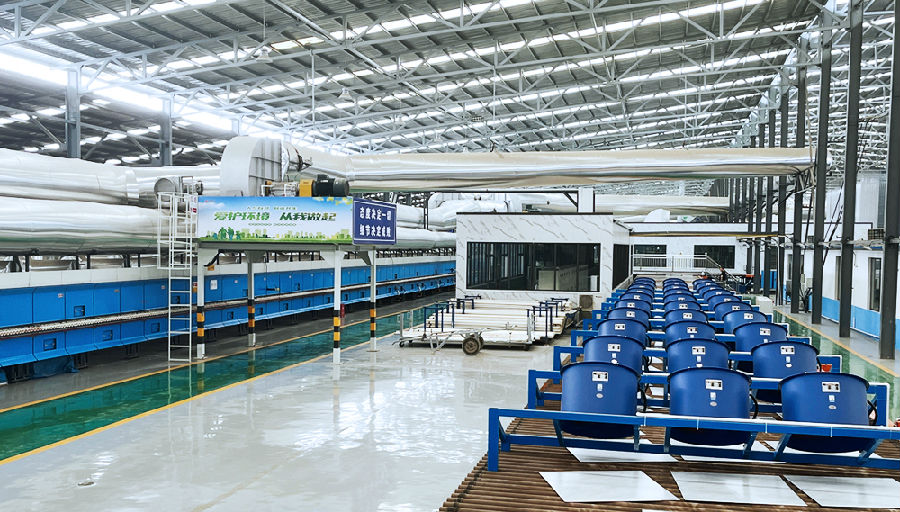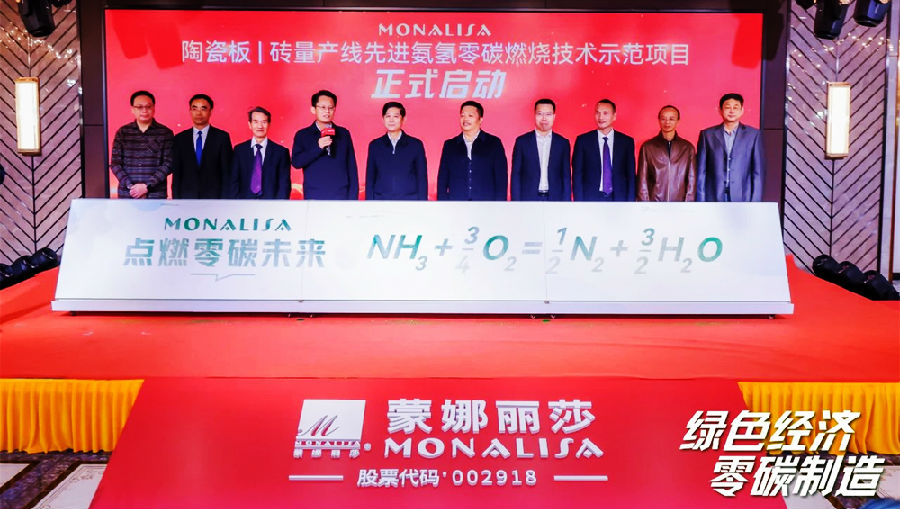On February 18, 2022, the intelligentproduction line for sintered stones/large slabs built by HLT&DLT for HenanZhongqi Ceramics was successfully launched. It has been operating continuouslyever since. Significantly,this is a wide-body kiln with a fuel composition of 60% hydrogen, an innerwidth of 3.1 m, and a current daily production of 38,000 ㎡. This marks another breakthrough by DLT in low-carboncombustion technology.
Here comes thequestions. Why was the high-hydrogen wide-body kiln first established in theHenan production area? What challenges did the technical development face? Whatis the significance of hydrogen-powered kilns?
To answer these questions, Mr. Ceramic hasspecially invited DLT Technical Director, Mr. Xiru CHENG, to shed light on theins and outs of DLT's research and application of hydrogen energy.
| Overcoming Challenges
For Hydrogen's Fast Combustion and Short Flame, How to Adapt to High-OutputWide-Body Kilns
As environmental requirements intensify,ceramic enterprises increasingly demand clean energy. Hydrogen energy, with itshigh calorific value, non-toxicity, and zero carbon emissions, has been a focusof DLT's efforts in energy conservation and carbon reduction. The company beganits R&D of hydrogen technology many years ago. During the COVID-19pandemic, travel restrictions inadvertently provided DLT's researchers withample time to overcome key technical challenges related to high-hydrogenwide-body kilns.
Mr. Xiru CHENG pointed out three maintechnical challenges faced by high-hydrogen wide-body kilns:
· First, in actual production, hydrogen burns quickly andhas a short flame. Meanwhile, the wide-body kiln with large output hassignificant cross-sectional temperature differences. Adapting these two factors requiresaddressing the issue of high-speed injection through careful burner selectionand design. Additionally, the short flame and concentrated high heat fromhydrogen combustion can affect the lifespan of kiln materials, such as kilnwalls and silicon carbide sleeves. Therefore, these factors must be fullyconsidered in kiln design.
· Second, hydrogen is highly reactive, posing a backfire challenge. To address this, DLT introduced check valves and other components.
· Third, the material design and construction standards for hydrogen pipelines must strictly comply with the Chinese national standard GB 4962-2008 Technical safety regulation for gaseous hydrogen use.
As DLT overcame the key technical challengesof high-hydrogen wide-body kilns, a significant favorable development emerged:China announced clear timelines for achieving carbon peak and carbonneutrality. On September 22, 2020, at the General Debate of the 75th Session ofthe United Nations General Assembly, China announced its aim to reach peakcarbon emissions by 2030 and achieve carbon neutrality by 2060.

This serious commitment to the carbon peak andcarbon neutrality strategy has drawn significant attention both in China andthe international community. It also provided authoritative Chinese national endorsementand momentum for high-tech enterprises like DLT, which are dedicated to energysaving and carbon reduction.
In the meantime, Henan Zhongqi Ceramicsplanned to build a new intelligent production line for sintered stones/largeslabs. Using its advantage of being in a high-hydrogen fuel gas area, ZhongqiCeramics partnered with HLT&DLT, which has extensive experience in hydrogenenergy, to initiate a high-hydrogen wide-body kiln project in August 2021.
| Implementation
Outstandingresults in cost reduction and efficiency improvement, Significant energy-savingand carbon-reduction effects
Just six months after the project initiation,on February 18, 2022, the intelligent production line of sintered stones/largeslabs for Henan Zhongqi Ceramics, constructed by HLT&DLT, waslaunched. This linefeatures a wide-body kiln with an internal width of 3.1 m, a daily productioncapacity of 38,000 ㎡, and a fuel hydrogen content of 60%. It has opened a new chapter for high-hydrogenwide-body kilns in the ceramics industry.
To date, due to its energy advantages, thishigh-hydrogen wide-body kiln has shown significant characteristics in costreduction, efficiency improvement, and energy saving and carbon reduction.According to Mr. Xiru CHENG, thefuel costs of this production line are about 30% lower than using natural gaslocally. Customers report that the kiln not only has evident energy-saving advantages butalso produces high-quality products.
The carbon reduction effects are also highlysignificant. At current production levels, using high-hydrogen mixed gasresults in approximately 30,200 tons of CO2 emissions annually.If natural gas were used instead, the emissions would be about 41,000 tons peryear. In contrast, thehigh-hydrogen wide-body kiln reduces CO2 emissions byapproximately 26%.

Additionally, the production line is equippedwith HLT&DLT's advanced DDI4.0-A intelligent central control system. Thesystem utilizes cloud computing and comprehensive management to overcomespatial and temporal limitations, enabling remote monitoring of the productionline.
| Refinement
Ammonia-HydrogenCombustion Technology Soon to Be Mass-Produced, Laying the Foundation for the"Zero Carbon Era"
HLT&DLT, grounded in innovation, is notcontent with the breakthroughs achieved with high-hydrogen wide-body kilns. Thetechnological development route and industrial practice from carbon reductionto low carbon and then to zero carbon represent DLT's clear plan to achieve thecarbon peak and carbon neutrality goals.
On December 27, 2021, DLT, together withFoshan Xianhu Laboratory and OCEANO Ceramics, established the "Advanced Zero Carbon CombustionTechnology Joint Innovation R&D Center". On December18, 2022, they produced theworld's first "zero-carbon ceramic tile" using ammonia-hydrogen fuel. Thismarked a significant milestone.
On October 28, 2023, DLT, Foshan XianhuLaboratory, Oushenno, Monalisa, and Anqing Technology launched the "Ceramic Slab and Tile MassProduction Line Advanced Ammonia-Hydrogen Zero Carbon Combustion TechnologyDemonstration Project". They plan to launch the productionline in the second half of 2024.
Mr. Xiru CHENG stated that for the massproduction line of "ammonia-hydrogen zero carbon combustiontechnology", all 5 companies are leveraging their strengths. With noreference cases to follow, they had to build the technical procedures forammonia-hydrogen fuel transport, storage, and combustion from scratch. Happily,this challenging process has been successfully overcome.
Theupcoming mass production of the "ammonia-hydrogen zero carbon combustiontechnology demonstration project" represents a forward-looking layout bythe five companies such as DLT focusing on the future. This marks a significantleap from theory to practice. It will lay a solid foundation for the ceramicsindustry to advance towards the "zero carbon era".
It also opens a new path for the low-carbon transformation of thehigh-temperature manufacturing industries through the application of the"new quality productive forces". This projectcontributes important technological support to the carbon peak and carbon neutralitystrategy.
 簡體中文
簡體中文 English
English

















 News Center
News Center
















